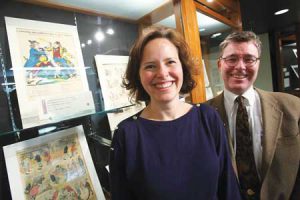
By Katherine Gombay
The signs are all there. You just have to know how to read them.
In his portrait Dr. Edward Jenner sits looking straight out at the viewer, his left hand casually turning the pages of a book. Behind one shoulder is a pastoral scene with milkmaids and cows, while behind the other hangs an image of another cow with a star on its head and the words ‘sacred cow’ above it.
For the viewer who knows little about Jenner, all these cattle might be seen simply as expressions of an obsession with bovines. But for those in the know, the cows that surround Jenner, an English physician who is often credited with being the “father of immunology,” act to remind viewers of his medical discoveries and reinforce his claim to fame.
After noticing that milkmaids who had been exposed to cowpox, a relatively minor illness, never developed the potentially deadly disease of smallpox, Jenner took pus from cowpox blisters and then inoculated a young boy with it. Although the child is said to have suffered some minor pain, he never developed either full-blown cowpox or smallpox. Hence the importance of cattle in Jenner’s life, and their place in his portrait.
This portrait is part of the Osler Library’s collection of 2,500 medical prints that span the last three centuries, and includes medical caricatures, scenes and advertisements as well as drawings and photographs. “My favourite style of portraiture is the head-on-hand thinking pose,” says art historian Mary Hunter, who regularly brings her classes to work with the material in the Osler Library. “Scientists and doctors were actively involved in discussing with the artists how they would be portrayed. They often chose to surround themselves with objects from their collections, especially if they could be visually linked with a discovery, even while debate was still going on about who was responsible for it.”
But while medical portraiture allowed doctors to work with the artists to create images that would emphasize both their discoveries and their professional standing, there was a parallel strand of medical imagery in the popular press at the same period where doctors had far less control over the way they were being presented, and where as a result they appear in a very different light.
Among the cartoons from the 18th and 19th centuries, some images in the collection show physicians with different opinions arguing with one another about the best course of treatment as the patient lies dying beneath their feet; others point to the excessive costs of consulting; while still others mock the privileged and possibly lascivious gaze of medical men as they examine languid young women. According to Hunter, these images from the popular presses are reflective of the anxiety and fears that people felt generally about various aspects of the medical profession.
To view the collection online: http://digital.library.mcgill.ca/oslerprints/index.php
